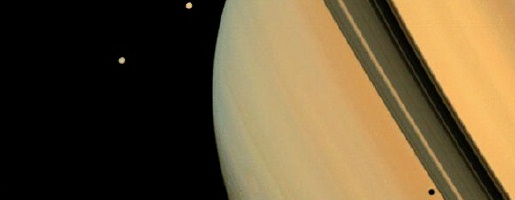 |
||
|
Voyager
view of Dione and Tethys, with Tethys casting a shadow onto Saturn.
|
||
| TETHYS - MOON OF SATURN | ||
| Tethys was a goddess of the ocean. She bore 3000 children by her brother, Oceanus, which became the streams, lakes and rivers. Features on Tethys are named after characters and places from Homers' epic tale, the "Odyssey". Tethys was discovered by the Italian astronomer Cassini in 1684, in the same year he discovered Dione. | ||
| Orbit | ||
| Tethys orbits 295,000 kilometres from the centre of Saturn. It follows a circular path, inclined only very slightly (1.09o) to the plane of Saturn's equator. Discovered by Smith and Pasco, using Voyager images, were two small moons co-orbital with Tethys. These were named Telesto and Calypso. They are Trojan as they occupy Tethys' Lagrange points, 60o ahead 60o behind the moon's orbit. | ||
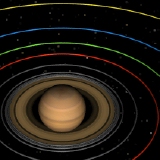 The orbits of Enceladus, Tethys, Telesto, Calypso, Dione, Helene, and Rhea. |
 Voyager view of Dione and Tethys, with Tethys casting a shadow onto Saturn. |
|
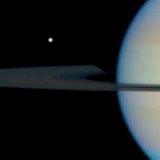 Hubble Space Telescope image of Saturn, Saturn's edge-on rings, and Tethys. |
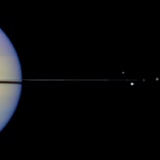 Hubble Space Telescope image of Mimas, Tethys, Janus and Enceladus, clustered at the western side of the edge-on ring system. |
|
| Physical properties | ||
| Tethys is about the same size as Dione, just a little bit smaller, measuring 1050 kilometres across. Its density is 1000 kg m-3 which is equal to that of water. | ||
| Interior | ||
| Tethys' density, the same as water, suggests that Tethys is mostly water ice. It may have a small amount of rock, but if so it must be a very small amount. This means that Tethys is virtually a huge lump of ice, but with the very low temperatures at Saturn the ice is as hard as steel. | ||
| Magnetic field | ||
| No magnetic field has been detected. | ||
| Atmosphere | ||
| No atmosphere has been detected. | ||
| Surface | ||
| Voyager 2 made a close flyby of Tethys and obtained good images of nearly all the moon's surface. | ||
| Tethys is bright, its albedo is nearly 0.9 and it is among the most reflective of the Saturnian satellites. Nearly all solar radiation is reflected back into space, the surface therefore is very cold, 86 K (-187oC). | ||
| There are the two main types of terrain: heavily cratered and fractured, but there are no clear boundaries between the different landscapes. Some areas are more fractured and others more heavily cratered. Quite often movement of the surface and intense meteorite bombardment appear to have been happening at the same time. | ||
| The largest of Tethys' deep valleys or chasmata is Ithaca Chasma, which is named after Odysseus' kingdom. Ithaca is up to 100 kilometres wide and runs for about 2000 kilometres around the globe. It extends from the north polar region across the equator towards the south pole. The edges of Ithaca Chasma are slightly raised and are 500 metres above the surrounding plains surface. | ||
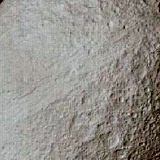 Ithaca Chasma is the largest and deepest valley on Tethys. |
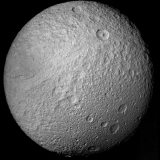 Voyager image of Tethys, showing a close-up view of Ithaca Chasma. |
|
| Ithaca was thought to have formed when the surface froze and was jostled about above an unfrozen liquid layer, forming a large crack. Why the crack is oriented as it is, isn't known; nor is it known why there are not more large cracks or even a pattern of fractures. It is calculated that the extension caused by freezing would generate cracks equivalent in width to the chasmata observed on Tethys. There are also plenty of shorter and narrower grooves and ridges, some of which are braided together, forming twisting and interlocking patterns. | ||
| Tethys' other important terrain are the densely cratered surfaces. There is a wide range of different sized craters and types. Most of the smaller 10 to 40 kilometres craters are simple basins. Craters larger than about 50 kilometres in diameter often have a central peak or a pit. Odysseus Crater, located in Tethys' western hemisphere is the very largest and measures 400 kilometres across, equivalent in diameter to Mimas. | ||
 Voyager image of Tethys showing the crater Odysseus. |
||
| Odysseus has a central peak, and is the largest crater with a well-developed central peak so far found in the Solar System. A peak in such a large crater is quite unusual. Large impacts normally form impact basins like Caloris on Mercury and Orientale on our Moon. Instead Odysseus may have formed a regular crater with a peak because Tethys may have either no crust, or, a very thick crust which is homogeneous (the same mixture) for a great depth.Odysseus Hubble Space Telescope image of Saturn, Saturn's edge-on rings, and Tethys.Within the main rim of Odysseus are terraces. These step-like concentric ridges appear worn and degraded. They may have once been part of the main rim and have collapsed, or part of the crater floor which rebounded following the impact. There are many different ideas how Tethys has evolved. It has also been suggested that Tethys was partially molten at the time it was struck by the object which formed Odysseus Crater. The impact would otherwise have broken Tethys apart. | ||
| It has also been speculated that the formation of Ithaca Chasma and Odysseus Crater are somehow linked. Some geologists have suggested, as they have with Mimas, that Tethys was struck in its early history by impacts so large that it was broken apart and reformed in a manner originally thought to account for the mixed up landscape of Uranus' moon Miranda. | ||
|
|
||